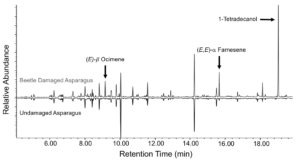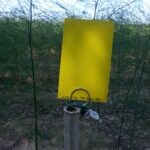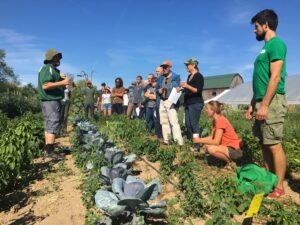Project Overview
Commodities
- Vegetables: asparagus
Practices
- Crop Production: foliar feeding, application rate management
- Education and Training: extension, on-farm/ranch research, workshop
- Natural Resources/Environment: biodiversity
- Pest Management: biological control, integrated pest management
- Production Systems: organic agriculture
- Soil Management: soil quality/health
Abstract:
Feeding by herbivores induces production of volatile secondary plant metabolites that play important roles in mediating plant-insect interactions in agroecosystems. By acting as prey location cues for predator and parasitoid insects, herbivore induced plant volatiles (HIPVs) can increase interactions between natural enemies and prey and have become an area of interest for biological pest control programs that seek to attract natural enemies into production fields from natural habitats. For specialty crop growers of the North Central Region, use of HIPV lures could have particular value in management programs as alternatives to chemical pest controls. However, such programs must be tailored to specific crops, target pests and relevant natural enemies to be effective.
[caption id="attachment_505799" align="alignleft" width="300"] Figure 1. Representative GC/MS headspace profiles collected in the field from one-year-old asparagus ferns treated with either 20 asparagus beetle larvae, fed ad libitum for 48 h, or an undamaged asparagus plant. Arrows indicate compounds that were upregulated in response to beetle feeding. Mechanically damaged ferns had profiles similar to undamaged asparagus (data not shown).[/caption]
Figure 1. Representative GC/MS headspace profiles collected in the field from one-year-old asparagus ferns treated with either 20 asparagus beetle larvae, fed ad libitum for 48 h, or an undamaged asparagus plant. Arrows indicate compounds that were upregulated in response to beetle feeding. Mechanically damaged ferns had profiles similar to undamaged asparagus (data not shown).[/caption]
Our previous research found that asparagus produces significantly higher concentrations of HIPVs (e)-beta-ocimene, (e e)-alpha-farnesene, and (1)-tetradecanol than healthy plants following 48 hours of feeding by common asparagus beetle larva (Crioceris asparagi), a monophagous feeder of asparagus globally (Fig. 1). Y-tube olfactometer tests with a polyphagous predator, the convergent lady beetle (Hippodamia convergens), demonstrated some attraction to asparagus HIPV’s at specific concentrations in a lab setting. The goal of this research was to build upon these findings to develop a field deployed HIPV lure that can attract natural enemies from field border habitats into production fields to increase natural enemy-prey interactions in an effort to control key crop pests.
[caption id="attachment_505791" align="alignright" width="150"] Figure 2. HIPV lures were deployed on the edge of asparagus fields to recruit natural enemies.[/caption]
Figure 2. HIPV lures were deployed on the edge of asparagus fields to recruit natural enemies.[/caption]
We placed HIPV lures baited with two concentrations of ocimene and farnesene, mixtures of the two, and controls on field edges of 12 commercial asparagus fields for 8 weeks, post-harvest (Fig. 2). Immediately following lure deployment, we released 100 marked convergent lady beetles 10 m from each lure, into the field border habitat, to determine if this predator was attracted to lures in the field. Lures were deployed with sticky traps, replaced weekly, and all insects collected on the traps were identified as crop pests, predators, parasitoids, or marked lady beetles. We found that in all HIPV lure concentrations and mixtures tested that parasitoids were more attracted to HIPV lures than our controls. However, predators were not attracted to lures and we only recaptured three marked lady beetles that were released over the entire experiment. Fortunately, crop pests were also not attracted to our lures. Our research findings demonstrate that HIPV lures deployed in asparagus agroecosystems may increase parasitoid-pest interaction, without increasing pest pressure, by recruiting parasitoids from field border habitats into field edges.
[caption id="attachment_505744" align="alignleft" width="300"]
 Figure 3. Field day attendees participated in hands-on demonstrations on the use of volatile lures to attract natural enemies in agricultural crops.[/caption]
Figure 3. Field day attendees participated in hands-on demonstrations on the use of volatile lures to attract natural enemies in agricultural crops.[/caption]
As part of this project, we conducted educational outreach to promote the use of lure technology in scouting and biological pest control by small farmers in Michigan. This effort resulted in seven conference presentations, five research poster presentations, one field day, and is part of a larger manuscript currently under review by a peer-reviewed journal. Conference and poster presentations were made to researchers and farmers, while the field day was focused on beginning farmers and farmer veterans (military veterans). Our field day was attended by 20 farmers (2 of which were veterans) (Fig. 3). The workshop provided training on the use of lure technologies to support pest management, the use of cover crops to support natural enemy communities, the use of attract and kill technologies for pest management, and how to access resources and programs through Michigan State University Extension and USDA to support adoption of these management practices. A formal survey was conducted at the end of the workshop and the results are reported herein.
Project objectives:
The primary goal of this research was to investigate the use of herbivore induced plant volatiles (HIPV) in field deployed lures as recruitment tools for natural enemies of common asparagus beetle (Crioceris asparagi) and the asparagus miner (Ophiomyia simplex) in an effort to increase natural enemy-prey interactions. Educational outcomes were accomplished through oral and poster presentations, an on farm workshop, and state-wide outreach with Michigan Food and Farming Systems (501c3) which educated researchers and farmers on the use of lures in agricultural pest management and scouting. Overall, we sought to increase grower adoption of biological pest management strategies in specialty crops, increase predator-prey interactions in asparagus agroecosystems through HIPV lures, and decrease the use of broad spectrum insecticides in asparagus production in the North Central Region.